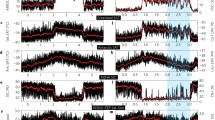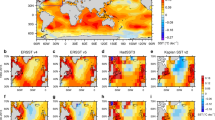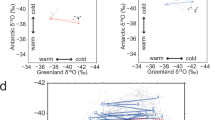Abstract
The last glacial period was punctuated by abrupt climate changes that are widely considered to result from millennial-scale variability of the Atlantic meridional overturning circulation (AMOC). However, the origin of these AMOC reorganizations remains poorly understood. The climatic connection between both hemispheres indicated by proxies suggests that the Southern Ocean (SO) could regulate this variability through changes in winds and atmospheric CO\(_{2}\) concentration. Here, we investigate this hypothesis using a coupled climate model forced by prescribed CO\(_{2}\) and SO wind-stress variations. We find that the AMOC exhibits an oscillatory behavior between weak and strong circulation regimes which is ultimately caused by changes in the meridional density gradient of the Atlantic Ocean. The evolution of the simulated climatic patterns matches the amplitude and timing of the largest events that occurred during the last glacial period and their widespread climatic impacts. Our results suggest the existence of an internal interhemispheric oscillation mediated by the bipolar seesaw that could promote glacial abrupt climate changes through variations in atmospheric CO\(_{2}\) levels, the strength of the SO winds and AMOC reorganizations, and provide an explanation for the pervasive Antarctic-like climate signal found in proxy records worldwide.








Similar content being viewed by others
References
Abernathey R, Marshall J, Ferreira D (2011) The dependence of Southern Ocean meridional overturning on wind stress. J Phys Oceanogr 41(12):2261–2278. doi:10.1175/JPO-D-11-023.1
Ahn J, Brook E (2008) Atmospheric CO\(_{2}\) and climate on millennial time scales during the last glacial period. Science 322(5898):83–85. doi:10.1126/science.1160832
Alley R, Clark P, Keigwin L, Webb R (1999) Making sense of millennial-scale climate change. Geophys Monogr Ser 112:385–394
Anderson RF, Ali S, Bradtmiller LI, Nielsen SHH, Fleisher MQ, Anderson BE, Burckle LH (2009) Wind-driven upwelling in the Southern Ocean and the deglacial rise in atmospheric CO\(_{2}\). Science 323(5920):1443–1448. doi:10.1126/science.1167441
Banderas R, Alvarez-Solas J, Montoya M (2012) Role of CO\(_{2}\) and Southern Ocean winds in glacial abrupt climate change. Clim Past 8(3):1011–1021. doi:10.5194/cp-8-1011-2012
Barker S, Knorr G (2007) Antarctic climate signature in the Greenland ice core record. Proc Natl Acad Sci 104(44):17278–17282. doi:10.1073/pnas.0708494104
Blunier T, Brook EJ (2001) Timing of millennial-scale climate change in Antarctica and Greenland during the last glacial period. Science 291:109–11. doi:10.1038/29447
Bond G, Heinrich H, Broecker W, Labeyrie L, McManus J, Andrews J, Huon S, Jantschik R, Clasen S, Simet C, Tedesco K, Klas M, Bonani G, Ivy S (1992) Evidence for massive discharge of icebergs into the North Atlantic ocean during the last glacial. Nature 360:245–249. doi:10.1038/360245a0
Ceppi P, Hwang YT, Liu X, Frierson DM, Hartmann DL (2013) The relationship between the ITCZ and the Southern Hemispheric eddy-driven jet. J Geophys Res Atmos 118. doi:10.1002/jgrd.50461
Chiang J, Bitz C (2005) Influence of high latitude ice cover on the marine Intertropical Convergence Zone. Clim Dyn 25(5):477–496. doi:10.1007/s00382-005-0040-5
Crowley TJ (1992) North Atlantic deep water cools the Southern Hemisphere. Paleoceanography 7:489–497. doi:10.1029/92PA01058
Dansgaard W, Johnsen S, Clausen H, Dahl-Jensen D, Gundestrup N, Hammer C, Hvidberg C, Steffensen J, Sveinbjörnsdottr A, Jouzel J et al (1993) Evidence for general instability of past climate from a 250-kyr ice-core record. Nature 364:218–220. doi:10.1038/364218a0
Denton G, Anderson R, Toggweiler J, Edwards R, Schaefer J, Putnam A (2010) The last glacial termination. Science 328(5986):1652. doi:10.1126/science.1184119
Dokken TM, Nisancioglu KH, Li C, Battisti DS, Kissel C (2013) Dansgaard–oeschger cycles: interactions between ocean and sea ice intrinsic to the Nordic seas. Paleoceanography 28(3):491–502. doi:10.1002/palo.20042
Ganopolski A, Rahmstorf S (2001) Rapid changes of glacial climate simulated in a coupled climate model. Nature 409:153–158. doi:10.1038/35051500
Gnanadesikan A (1999) A simple predictive model for the structure of the oceanic pycnocline. Science 283:2077–2079. doi:10.1126/science.283.5410.2077
Hallberg R, Gnanadesikan A (2006) The role of eddies in determining the structure and response of the wind-driven Southern Hemisphere overturning: results from the modeling eddies in the Southern Ocean (MESO) project. J Phys Oceanogr 36(12):2232–2252
Huber C, Leuenberger M, Spahni R, Flückiger J, Schwander J, Stocker T, Johnsen S, Landais A, Jouzel J (2006) Isotope calibrated Greenland temperature record over Marine Isotope Stage 3 and its relation to CH\(_{4}\). Earth Planet Sci Lett 243(3–4):504–519. doi:10.1016/j.epsl.2006.01.002
Keeling RF, Stephens BB (2001) Antarctic sea ice and the control of Pleistocene climate instability. Paleoceanography 16(1):112–131. doi:10.1029/2000pa000529
Knorr G, Lohmann G (2003) Southern Ocean origin for the resumption of the Atlantic thermohaline circulation during deglaciation. Nature 424:532–536. doi:10.1038/nature01855
Knorr G, Lohmann G (2007) Rapid transitions in the Atlantic thermohaline circulation triggered by global warming and meltwater during the last deglaciation. Geochem Geophys Geosyst 8(12):Q12,006. doi:10.1029/2007GC001604
Krebs U, Timmermann A (2007) Tropical air–sea interactions accelerate the recovery of the Atlantic meridional overturning circulation after a major shutdown. J Clim 20(19):4940–4956. doi:10.1175/JCLI4296.1
Landais A, Barnola J, Masson-Delmotte V, Jouzel J, Chappellaz J, Caillon N, Huber C, Leuenberger M, Johnsen S (2004) A continuous record of temperature evolution over a sequence of Dansgaard–Oeschger events during Marine Isotopic Stage 4 (76 to 62 kyr BP). Geophys Res Lett 31(22). doi:10.1029/2004GL021193
Lang C, Leuenberger M, Schwander J, Johnsen S (1999) 16\(^\circ\)C rapid temperature variation in central Greenland 70,000 years ago. Science 286(5441):934. doi:10.1126/science.286.5441.934
Lee S, Chiang J, Matsumoto K, Tokos K (2011) Southern Ocean wind response to North Atlantic cooling and the rise in atmospheric CO\(_{2}\): modeling perspective and paleoceanography implications. Paleoceanography 26:PA1214. doi:10.1029/2010PA002004
Li C, Battisti DS, Bitz CM (2010) Can North Atlantic sea ice anomalies account for Dansgaard-Oeschger climate signals? J Clim 23(20). doi:10.1175/2010JCLI3409.1
Liu Z, Otto-Bliesner B, He F, Brady E, Tomas R, Clark P, Carlson A, Lynch-Stieglitz J, Curry W, Brook E et al (2009) Transient simulation of last deglaciation with a new mechanism for Bolling–Allerod warming. Science 325(5938):310–314. doi:10.1126/science.1171041
Martínez-García A, Sigman DM, Ren H, Anderson RF, Straub M, Hodell DA, Jaccard SL, Eglinton TI, Haug GH (2014) Iron fertilization of the Subantarctic Ocean during the last ice age. Science 343(6177):1347–1350. doi:10.1126/science.1246848
Menviel L, Timmermann A, Friedrich T, England M (2014) Hindcasting the continuum of Dansgaard–Oeschger variability: mechanisms, patterns and timing. Clim Past 10(1):63–77. doi:10.5194/cp-10-63-2014
Montoya M, Levermann A (2008) Surface wind-stress threshold for glacial Atlantic overturning. Geophys Res Lett 35(L03):608. doi:10.1029/2007GL032560
Montoya M, Griesel A, Levermann A, Mignot J, Hofmann M, Ganopolski A, Rahmstorf S (2005) The Earth system model of intermediate complexity CLIMBER-3\(\alpha\). Part I: description and performance for present day conditions. Clim Dyn 25:237–263. doi:10.1007/s00382-005-0044-1
Mosblech NA, Bush MB, Gosling WD, Hodell D, Thomas L, van Calsteren P, Correa-Metrio A, Valencia BG, Curtis J, van Woesik R (2012) North Atlantic forcing of Amazonian precipitation during the last ice age. Nat Geosci 5(11):817–820. doi:10.1038/ngeo1588
Peltier W (2004) Global glacial isostasy and the surface of the ice-age Earth: the ICE-5 G(VM 2) model and GRACE. Ann Rev Earth Plan Sci 32(1):111–149. doi:10.1146/annurev.earth.32.082503.144359
Petersen S, Schrag D, Clark P (2013) A new mechanism for Dansgaard–Oeschger cycles. Paleoceanography. doi:10.1029/2012PA002364
Rahmstorf S (1996) On the freshwater forcing and transport of the Atlantic thermohaline circulation. Clim Dyn 12:799–811. doi:10.1007/s003820050144
Rashid H, Hesse R, Piper D (2003) Evidence for an additional Heinrich event between H5 and H6 in the labrador sea. Paleoceanography 18(4):1077. doi:10.1029/2003PA000913
Rooth C (1982) Hydrology and ocean circulation. Prog Oceanogr 11:131–149
Schewe J, Levermann A (2010) The role of meridional density differences for a wind-driven overturning circulation. Clim Dyn 34:547–556. doi:10.1007/s00382-009-0572-1
Stocker TF (1998) The seesaw effect. Science 282:61–62. doi:10.1126/science.282.5386.61
Stocker TF (2003) South dials north. Nature 424:496–499. doi:10.1038/424496a
Stommel H (1961) Thermohaline convection with two stable regimes of flow. Tellus 13:224–230. doi:10.1111/j.2153-3490.1961.tb00079.x
Toggweiler JR (2009) Shifting westerlies. Science 323(5920):1434–1435. doi:10.1126/science.1169823
Toggweiler JR, Lea D (2010) Temperature differences between the hemispheres and ice age climate variability. Paleoceanography 25(2):PA2212. doi:10.1029/2009PA001758
Toggweiler JR, Samuels B (1995) Effect of drake passage on the global thermohaline circulation. Deep-Sea Res 42:477–500. doi:10.1016/0967-0637(95)00,012-U
Toggweiler JR, Russell JL, Carson S (2006) Midlatitude westerlies, atmospheric CO\(_{2}\), and climate change during the ice ages. Paleoceanography 21(2):PA2005. doi:10.1029/2005PA001,154
Trenberth K, Olson J, Large W (1989) A global ocean wind stress climatology based on ECMWF analyses. Technical Report NCAR/TN-338+STR, National Center for Atmospheric Research, Boulder, Colorado, USA. doi:10.5065/D6ST7MR9
Wang X, Auler A, Edwards R, Cheng H, Ito E, Wang Y, Kong X, Solheid M (2007) Millennial-scale precipitation changes in southern Brazil over the past 90,000 years. Geophys Res Lett 34(23):L23,701. doi:10.1029/2007GL031149
Wang Y, Cheng H, Edwards R, An Z, Wu J, Shen C, Dorale J (2001) A high-resolution absolute-dated late Pleistocene monsoon record from Hulu Cave, China. Science 294(5550):2345. doi:10.1126/science.1064618
Watson AJ, Naveira Garabato AC (2006) The role of Southern Ocean mixing and upwelling in glacial-interglacial atmospheric CO\(_{2}\) change. Tellus B 58(1):73–87. doi:10.1111/j.1600-0889.2005.00167.x
Watson AJ, Ledwell JR, Messias MJ, King BA, Mackay N, Meredith MP, Mills B, Garabato ACN (2013) Rapid cross-density ocean mixing at mid-depths in the Drake Passage measured by tracer release. Nature 501(7467):408–411. doi:10.1038/nature12432
Acknowledgments
This work has been partially funded by the Spanish Ministry of Science and Innovation CGL2011-29672-C02-01. R.B. is supported by a predoctoral fellowship of the Universidad Complutense (UCM). Research by J.A.S. has been partially supported by a PICATA postdoctoral fellowship of the Moncloa Campus of International Excellence (UPM-UCM). AR is funded by the European Commission’s Marie Curie 7th Framework Programme. Computational resources have been provided by the Spanish Environmental Research Center (CIEMAT) in Madrid. We are grateful to J. Adkins, R. F. Anderson and A. Griesel for fruitful discussion and to the two anonymous reviewers for useful comments that have contributed to improve the manuscript.
Author information
Authors and Affiliations
Corresponding author
Electronic supplementary material
Below is the link to the electronic supplementary material.
Supplementary material 1 (mpg 3910 KB)
Rights and permissions
About this article
Cite this article
Banderas, R., Alvarez-Solas, J., Robinson, A. et al. An interhemispheric mechanism for glacial abrupt climate change. Clim Dyn 44, 2897–2908 (2015). https://doi.org/10.1007/s00382-014-2211-8
Received:
Accepted:
Published:
Issue Date:
DOI: https://doi.org/10.1007/s00382-014-2211-8




